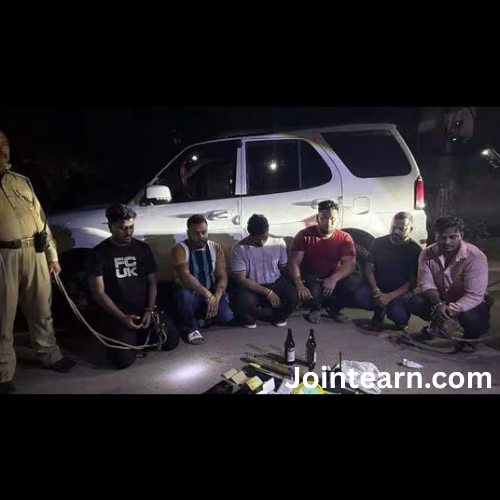Updated on: October 18, 2025 | Kolkata
Kolkata’s air quality plummeted sharply on Saturday, just two days before Kali Puja, with several monitoring stations across the city recording Air Quality Index (AQI) levels in the ‘poor’ category. The worsening air came amid sporadic reports of firecrackers being burst in parts of the city. However, the West Bengal Pollution Control Board (WBPCB)clarified that the decline in air quality was not directly linked to fireworks, but rather to weather conditions and increased particulate matter concentration following the withdrawal of the monsoon.
AQI Nears 250 in Parts of Kolkata
According to WBPCB data, the automated air quality monitoring station at Jadavpur, in the southern part of the city, registered an AQI of 242, while the Rabindra Bharati University station in Sinthi, in the north, recorded 252, both falling in the ‘poor’ category. The AQI had been significantly lower just a day earlier, ranging between 179 and 185 (PM 2.5) at 4 p.m. on October 17.
“The sudden spike in AQI is largely due to a change in meteorological conditions,” a senior WBPCB official said. “With the withdrawal of the monsoon, there is a lack of moisture and the particulate matter remains suspended in the air for longer periods. Even if some firecrackers were burst, their contribution was negligible and cannot be considered a deciding factor behind the worsening air quality.”
Construction, Dry Weather to Blame
Both Jadavpur and Sinthi, which are densely populated and heavily built-up areas, saw AQI levels rise as a result of active construction work and vehicular emissions, according to the pollution board. The official added that WBPCB monitoring teams will maintain round-the-clock vigilance during the Kali Puja and Diwali period, when pollution levels typically surge due to extensive firecracker use.
Residents have been urged to report any violation involving the bursting of banned or non-green firecrackers by contacting the WBPCB’s 24-hour control room.
Other City Areas Record ‘Moderate’ Air
In other parts of the city, the air quality remained in the ‘moderate’ range, but pollution levels were on the rise. At Ballygunge, the AQI stood at 143, while Fort William recorded 115 and Rabindra Sarobar measured 116, all within the moderate category. In Salt Lake, Kolkata’s satellite township, the AQI was 108.
By comparison, on October 17, these same areas had an average AQI of 152 (PM 2.5), indicating a steady deterioration as the festive period approached.
Experts Warn of Worsening Air During Festive Days
Environmental experts have raised concerns that the situation could worsen further as Kali Puja and Diwali celebrations intensify. Somendra Mohan Ghosh, a noted environmentalist, warned that the city’s air could soon reach ‘very poor’ (301–400) or even ‘severe’ (401–500) levels if preventive measures are not strictly implemented.
“There are reports that illegal firecrackers have already entered Kolkata’s markets from unlicensed units in South and North 24 Parganas districts,” Ghosh said. “The WBPCB and police seem to have slackened their vigilance this year, which could lead to widespread bursting of non-green fireworks.”
He added that the sound of crackers has been audible across several areas since Friday night, with a noticeable increase on Saturday evening. “If this continues, air quality may reach alarming levels on October 19, the eve of Kali Puja,” he cautioned.
Understanding AQI Categories and Health Impact
The Air Quality Index (AQI) serves as a composite measure of air pollution, particularly fine particulate matter (PM 2.5and PM 10). The Central Pollution Control Board (CPCB) categorizes AQI levels as follows:
- Good (0–50): Minimal impact on health.
- Satisfactory (51–100): Minor discomfort to sensitive individuals.
- Moderate (101–200): May cause breathing discomfort to people with lung or heart conditions.
- Poor (201–300): Causes breathing discomfort to most people upon prolonged exposure.
- Very Poor (301–400): Leads to respiratory illnesses and health effects with sustained exposure.
- Severe (401–500): Poses health risks even to healthy individuals and serious danger to those with existing diseases.
Given that Kolkata’s AQI is already hovering in the ‘poor’ range, experts fear the situation could escalate rapidly as particulate levels rise from firecracker emissions, traffic congestion, and stagnant air conditions.
WBPCB on High Alert
The West Bengal Pollution Control Board has reiterated its commitment to enforcing the National Green Tribunal (NGT) guidelines that permit only green firecrackers approved by the Council of Scientific and Industrial Research (CSIR). It has also deployed mobile surveillance units across the city to track violations and ensure that no banned fireworks enter public spaces.
“Our teams will remain on duty 24×7 during Kali Puja and Diwali,” the WBPCB official said. “We are coordinating with the Kolkata Police and local administrations to prevent illegal activities that contribute to air pollution.”
Outlook
While the pollution board attributes the current deterioration in air quality primarily to meteorological factors, environmentalists remain skeptical, pointing to the early use of fireworks and the unchecked sale of banned crackersas potential accelerators. With the festival season at its peak, Kolkata’s air quality is expected to come under further stress over the next few days.
Unless strong enforcement and public awareness measures are implemented immediately, the city may soon see its air quality slip into the ‘very poor’ or even ‘severe’ category — posing serious health risks to its residents and overshadowing the festive spirit of Kali Puja.


Leave a Reply